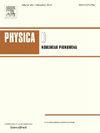Detecting causality in the frequency domain with Cross-Mapping Coherence
IF 2.7
3区 数学
Q1 MATHEMATICS, APPLIED
引用次数: 0
Abstract
Understanding causal relationships within a system is crucial for uncovering its underlying mechanisms. Causal discovery methods, which facilitate the construction of such models from time series data, hold the potential to significantly advance scientific and engineering fields.
This study introduces the Cross-Mapping Coherence (CMC) method, designed to reveal causal connections in the frequency domain between time series. CMC builds upon nonlinear state-space reconstruction and extends the Convergent Cross-Mapping algorithm to the frequency domain by utilizing coherence metrics for evaluation. We tested the CMC method using simulations of logistic maps, Lorenz systems, Kuramoto oscillators, and the Wilson–Cowan model of the visual cortex. CMC accurately identified the direction of causal connections in these simulated scenarios. When applied to the Wilson–Cowan model, CMC was able to disentangle feedforward alpha and feedback gamma coupling between the V1 and V4 areas, supporting the results of previous analysis.
Furthermore, CMC could detect weak connections (), demonstrated sample efficiency (), and maintained robustness in the presence of noise up to on unidirectionally coupled logistic map systems.
In conclusion, the capability to determine directed causal influences across different frequency bands allows CMC to provide valuable insights into the dynamics of complex, nonlinear systems.
用交叉映射相干检测频域因果关系
了解系统内的因果关系对于揭示其潜在机制至关重要。因果发现方法有助于从时间序列数据中构建此类模型,具有显著推进科学和工程领域的潜力。本研究引入了交叉映射相干(CMC)方法,旨在揭示时间序列之间频域的因果关系。CMC建立在非线性状态空间重构的基础上,利用相干度量将收敛交叉映射算法扩展到频域。我们使用逻辑图、洛伦兹系统、Kuramoto振荡器和视觉皮层的威尔逊-考恩模型的模拟来测试CMC方法。CMC准确地识别了这些模拟场景中因果关系的方向。当应用于Wilson-Cowan模型时,CMC能够解开V1和V4区域之间的前馈α和反馈γ耦合,支持了之前的分析结果。此外,CMC可以检测到弱连接(C=0.05),证明了样本效率(L=700),并且在单向耦合逻辑映射系统中存在高达10信噪比的噪声时保持鲁棒性。总之,通过不同频带确定直接因果影响的能力使CMC能够为复杂非线性系统的动力学提供有价值的见解。
本文章由计算机程序翻译,如有差异,请以英文原文为准。
求助全文
约1分钟内获得全文
求助全文
来源期刊

Physica D: Nonlinear Phenomena
物理-物理:数学物理
CiteScore
7.30
自引率
7.50%
发文量
213
审稿时长
65 days
期刊介绍:
Physica D (Nonlinear Phenomena) publishes research and review articles reporting on experimental and theoretical works, techniques and ideas that advance the understanding of nonlinear phenomena. Topics encompass wave motion in physical, chemical and biological systems; physical or biological phenomena governed by nonlinear field equations, including hydrodynamics and turbulence; pattern formation and cooperative phenomena; instability, bifurcations, chaos, and space-time disorder; integrable/Hamiltonian systems; asymptotic analysis and, more generally, mathematical methods for nonlinear systems.
 求助内容:
求助内容: 应助结果提醒方式:
应助结果提醒方式:


